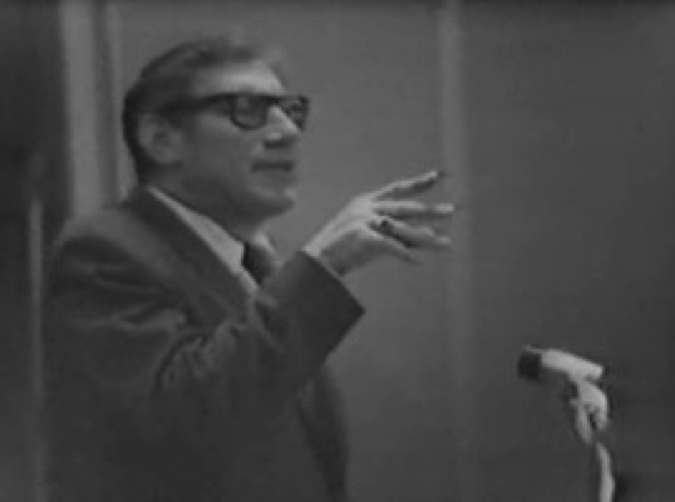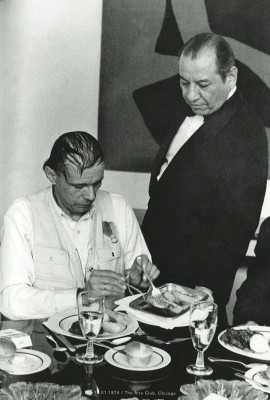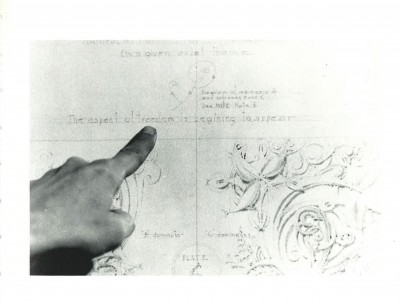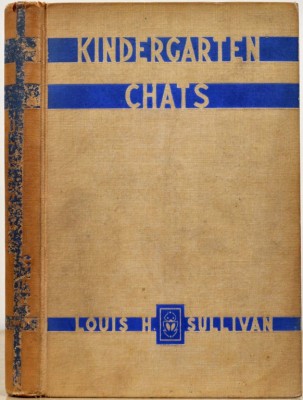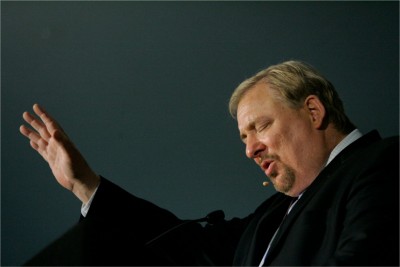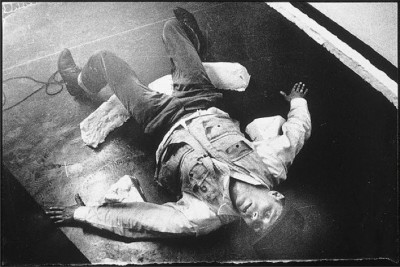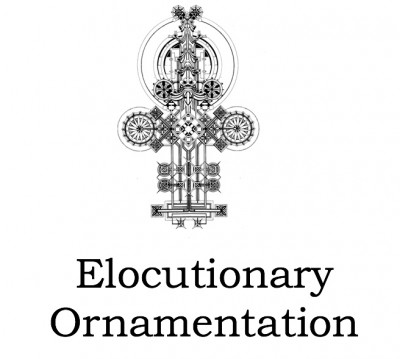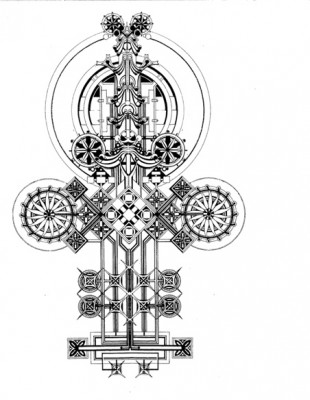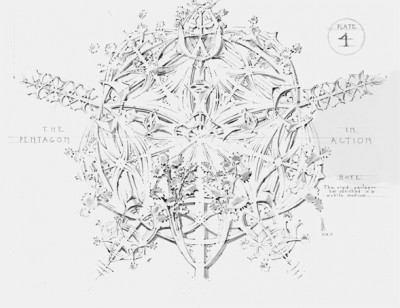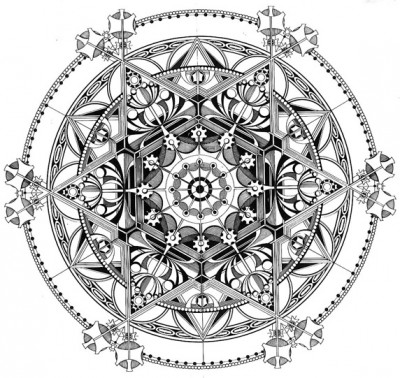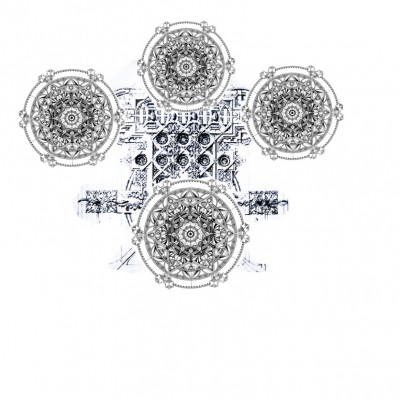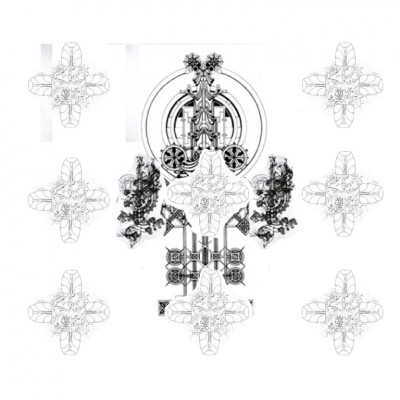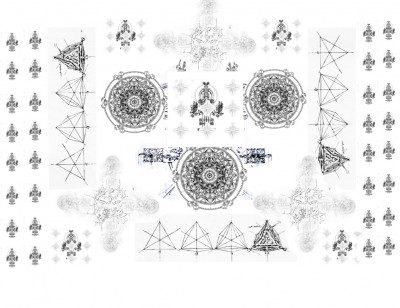An Aspect of Freedom (2016)
(performance lecture presented at the Arts Club of Chicago Centennial celebration on Saturday, October 22, 2016)
Ladies and Gentlemen:
It is an honor for me to speak to you today at the Arts Club, an organization that has inspired me for many years, ever since I first came to study art in this great city.
I am here to offer a performance lecture. This is a strange situation for me, since when I present these performance lectures I don’t traditionally warn the audience what they are going to encounter, or endure. And this is because I believe that content should precede format, and when you have built the expectation of a particular format the lecturer often struggles to deliver an satisfactory product. But I was honored by this kind invitation and could not say no to this privilege, so I will do my best.
One of the greatest architects of the modern era, and as you know a towering Chicago figure, often referred to as the father of modern architecture, Louis Sullivan, was a proponent of a key concept:
“form follows function”, which means that the shape of something should primarily obey its purpose.
I have been a museum educator for three decades, the majority of which I have spent developing public programs. From the beginning of my work in that rarified field I have noticed the great disconnect between form and function in art lecturing.
This is to say that the public presentation as a concept has a symbolic value in the academic world that often obscures the relevance of the content it conveys. In 1970, a psychological experiment was conducted
At the University of Southern California School of Medicine to doctoral students in medicine. It was taught by “Dr. Myron L. Fox”, a graduate of Albert Einstein College of Medicine, on the topic of “Mathematical Game Theory as Applied to Physician Education”.
In fact the speaker was an actor who presented a made up script, and was coached by specialists to deliver the material ‘with an excessive use of double talk, neologisms, non sequiturs, and contradictory statements.’ And yet, he displayed an engaging presence, strongly connecting with his audience, and interspersing his incongruent comments with humor. Nonetheless a substantial group of psychiatrists, psychologists, educators, graduate students and others considered the lecture a success. This experiment became known as “the Fox effect”.
Despite the fact that the fictional presenter, performed by this actor, had communicated absolutely nothing of any coherence or value, this audience had emotionally connected with the lecturer and had become convinced that the lecture had been intellectually stimulating, even if they had not understood a word of it. Herein lies the little discussed, but very real divide between integibillity and emotional convinction. We know from present experience that some people might listen to words that are utter nonsense, scandalous, and even alarming,
but the emotional connection with the figure Trumps any concerns we might have about what this figure might be saying.
But this only points to only one of the many ironies and paradoxes of lecturing. Some of these paradoxes were studied in the seminal book by Donald A. Bligh, What’s The Use of Lectures? Published back in 1971, the year I was born. Bligh, a sociologist and communicologist, convincingly makes the argument that lectures are ineffective means of persuasion, that they are constrained by the imposed structure of the scholarly world and that they don’t meet the educational goals intended by the institutions that offer them.
It is interesting to reflect that 45 years later, practically nothing has changed. It is true that we live in the era of the edutainment lecture, the Ted Talk that tries to break with the conventions of the traditional academic lecture. But we are seemingly years away to eliminate the academic conventions of today. We still sit through meaningless lectures, we connect emotionally to a speaker, and even in some situations regardless of what the speaker says, because we have established that emotional connection, we rather try to justify their ideas and conform them to our worldview.
But going back to Mr. Sullivan, what is happening here is that in this case, function follows form. I want to make a brief parenthesis to make a thematic connection with conceptual art, lectures, Sullivan and the place we are in right now.
There is a wonderful book compiling a photographic record of Beuys’ visit to Chicagoin 1974 that includes this photograph of the artist having dinner at the Arts Club in Chicago in 1974. We have ample records of his activities here, where he taught an important social sculpture-style lecture at the School of the Art Institute. The chalkboard resulting from that lecture is in the collection of the Art Institute.
It is undeniable that if we are to think of the lecture as an art form as we are doing here, we could not think of Joseph Beuys and how he approached this pedagogical approach as his medium. Given the interesting connections, it might not be a bad idea to think about him for a minute.
In the book, aside from the arts club photograph, there is also also a photo of his examination of a Louis Sullivan drawing in the Art Institute’s collection. In the photograph you can see Beuys’ finger pointing at a phrase that Sullivan himself had written: “The Aspect of Freedom is Beginning to Appear.”
It is perhaps not surprising that an artist like Beuys so strongly responded to Sullivan’s interest in expressing the forces of nature. Beuys’ lecture tour was titled “Energy Plan for the Western Man”. One wonders if he had been aware of Sullivan’s book titled “A System of Architectural Ornament According with a Philosophy of Man’s Powers.” Had it not inspired his original title, the book must have provided great affirmation to Beuys’ goals and interests. But I cannot provide a scholarly exploration of those ideas here. That could be the subject of a future scholarly lecture.
My purpose is really to talk about a different book by Sullivan, titled “Kindergarden Chats”, a book originally conceived as fifty-two separate articles that appeared weekly in the Interstate Architect and Builder from February 1901 to February 1902, later extensively revised for publication in 1918. The book however was not published until 1934, ten years after Sullivan’s death.
Despite its disarming title, the book is nonetheless a seminal publication that clearly outlines Sullivan’s theories about architecture, art and education. As it has been discussed, the book is primarily about architecture, but it uses architecture as a means to achieve larger educational reform.
I point all these details because I believe that as we consider the performance lecture as well as a major work written a hundred years ago, we may be well served by enacting a deconstructive process, a de-scaffolding, of the principle of form follows function, to understand the performative role of the lecture.
Joseph Beuys was an artist for whom, at least in theory, form followed function. However, looking at his work closely, it is more likely that in him function followed form.
Pastor Rick Warren writes: “In architecture, form follows function. Tell me what you want to use the building for, and I’ll tell you how to build it. But in human beings, it’s the exact opposite. Function follows form. Figure out how God shaped you and how he wired you, what he’s given you in spiritual gifts, heart, abilities, personality, and experience. Then you’ll know what you’re supposed to do with your life.”
It is often said that Beuys projected a Messianic figure, so it could be argued that his desire to have function follow form was in it of itself as form that followed function. In other words, that the idea of the format was more important than the content of the format itself. Like Dr. Fox, Beuys gave amazing pedagogical lectures, and everyone agreed they were amazing, but still we are not entirely sure what he really was talking about. The freedom had emerged to express itself in a form of freedom that had the freedom to not be anything other than an expression of freedom.
This paradox is true of a good deal of socially engaged art today: creating for instance a school is a great artistic idea, but when it comes to teaching it starts feeling a bit boring. The artistic idea has symbolic, not actual value.
In order to fully understand the inversion of the concept function follows form instead of form follows function I thought it would be useful to resort again to the wonderful book Kindergarden Chats by Louis Sullivan, where I will offer a small treatise of what I will term
“elocutionary ornamentation”.
This means that I will lecture incorporating terms and ideas that are valued primarily for their ornamental value, similar to the Fox lecture, although you might feel free to also find meaning in these ideas, as we often, and unavoidably, do with art.
In order to accomplish this, I will need your full attention at first, and then I will need you to get slightly distracted and connect with me primarily at an emotional level, which is not hard to do during events where you are asked to pay attention at all times. I hereby liberate you from paying attention of what I am saying. I will be asking you the opposite: to not pay attention.
First I will present to you a number of wonderful phrases from Mr. Sullivan’s Kindergarden Chats and relate them to a number of patterns created by him. Rest assured I won’t be doing ten lectures as eerily advertised in the misleading title I created, but I will rather take excerpts from ten of Sullivan’s Kindergarten chats to produce this experiment.
These patterns will slowly be incorporated into a beautiful edifice of words. And let me assure you, it is not easy to manage to make function follow form these days. Any lecture, any presentation, ultimately and ostensibly is about something, even if you don’t want it to: it is the great lesson from John Cage’s 4’33”. But just in its defense, this is a Kindergarten chat, a primary attempt at reaching meaning through building words, baby steps to hopefully abandon incongruence. Anything that is actually said that means something should be immediately disregarded. Only at that moment, it is my hope, that you might be able to start feeling that “An aspect of freedom is beginning to appear”.
And so here we go. First, the excerpts:
1. (VII- The Key)
Try never to forget, from now on, that everything, each thing you see and hear, has a double meaning: first, its outward meaning or aspect; second, its subjective or inner meaning and significance. Remember the word significance, it stands for that which we seek.
2. (XV- thought)
But in passing I may say that real thinking is better done without words than with them, and creative thinking must be done without words.
3.(XIV: another city)
Thus we are rounding out our absorbing study of Democracy. Thus, turning slowly upon the momentuous axis of our theme, are we coming more and more fully into the light of our sun: the refulgent and resplendent and life-giving sun of our art- an art of aspirant democracy!
4. (XXXVII: The elements of architecture)
Let me impress upon you again, let me inspire you with the idea, that everything you see around and about you, however near, however remote, however vast, however minute, however complex, apparently bewildering, confusing or awe-inspiring, has a simple basis.
5. (XXXIX: Illumination)
I have dreamed and dreamed. Dreamed of the lintel, the pier and the arch, as you have set them forth, and I have mused upon their implications, so subtle, so manifold.
6. (XL: on scholarship)
Far be it for me to underrate the studious habit of a serious mind in whatever channel it may chose to run. When sincerity and simplicity of heart are hand-maidens of such a mind, and a positive, definitive purpose to us is its goal, I am the last to say nay.
7. (XLI: on culture)
What strange and wonderful things words are. I have been thinking of the word culture. What a puzzling word it is. What is its real meaning at the core? For culture to be real, to ring true in this day and land, and for our people, must become democratic: as they must become.
8. (XLII: what is an architect?)
We are creatures of illusion and must remain ever such— for realities, as you have said, are divine; and they are of and for the Infinite; they are not for us.
9. (XLVI: Pessmimism)
Pessimism may become a passionate protest.
Because my soul is sick: I must have air. I must seek the open.
But it is winter.
Nevertheless, I go.
Then I go also.
10. (LI: Optimism)
Rembember, and bear ever in mind in your thinking and your doings, that FORM EVER FOLLOWS FUNCTION, that this is the law, a universal truth.
This is perhaps all that need be said by way of caution.
Let us not part before we greet the Spring.
Hope in the spring, it is the time for hope.
So shall we will, in the spring time,
It is our time for willing
now begin.
And now, building the scaffolding for function following form:
1+2
Try to never forget in passing that each real thought without words is better done when it has no meaning, as creative inner meaning should be done without seeking significance.
3+4
Thus we are rounding out our absorbing study of me impressing you again through the study of democracy. Everything you come to see more fully around you, however minute as the sun, however resplendent and life-giving, as a simple aspiration to democracy.
5+6
I have underrated my dreams, a serious mind that dreams of the lintel, the pier and he arth, I have mused upon its sincerity and simplicity of heart, and I am the last to say it is subtle. Nay.
7+8
What strange creatures of illusion our words are. I have been thinking of the word reality. What a puzzling word it is. What is its infinite meaning? For reality to be culture, it has to be imagination.
9+10
The joining pessismism and optimism are the passionate protest of form following function. Their union and the sickness of our soul is the universal truth. I go to both winter and spring for it is our time for hope to begin our protest.
1+2+3+4
Try to never forget as we round out our absorbing study of my real thoughts without words of democracy, this is better done when everything you see fully around you has no meaning, however minute as the sun, however resplendent and life-giving, without seeking a simple aspiration to democratic significance.
5+6+7
I have underrated how strange and wonderful are the dreams of a serious mind while thinking of the word culture. What puzzling is to muse upon the sincerity of its meaning. For dreams of culture to be real, to ring true in the simplicity of our hearts, people must become unsubtly democratic.
8+9+10
We are creatures of both pessimistic and optimistic illusions and must remain ever such as we protest form following function. The sickness of reality is divine and infinite, and even if it may not be for us, Winter and Spring become the seasons where we begin and end our ciclical protest during which, we believe, an aspect of freedom will start to appear.
And now,
1+2+3+4+5+6+7+8+9+10
Try to never forget as I have underrated how strange and wonderful we round out our absorbing study of both pessimistic and optimistic illusions that the dreams of a serious mind while thinking of the word culture We are creatures and must remain ever such as we protest form following function. What puzzling is to muse upon my real thoughts without words of democracy, as the sickness of reality is divine and infinite, and even if it may not be for us.
This is better done when everything you see fully around you has no meaning, in the simplicity of our hearts, however minute as Winter and Spring that become the seasons where we begin and end our dreams of culture however resplendent and life-giving, full of the sincerity of their meaning, For to ring true people must become unsubtly democratic without seeking a simple aspiration to democratic significance our ciclical protest during which, we believe, an aspect of freedom will start to appear.
Tags: Architecture, Education, Lecturing, Louis Sullivan, Nonsense, Psychology of Art
